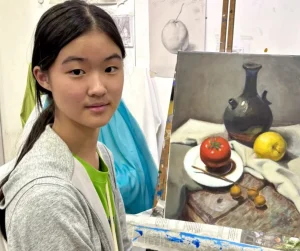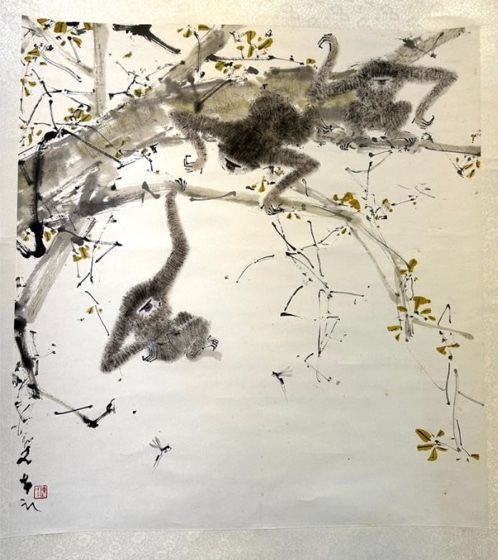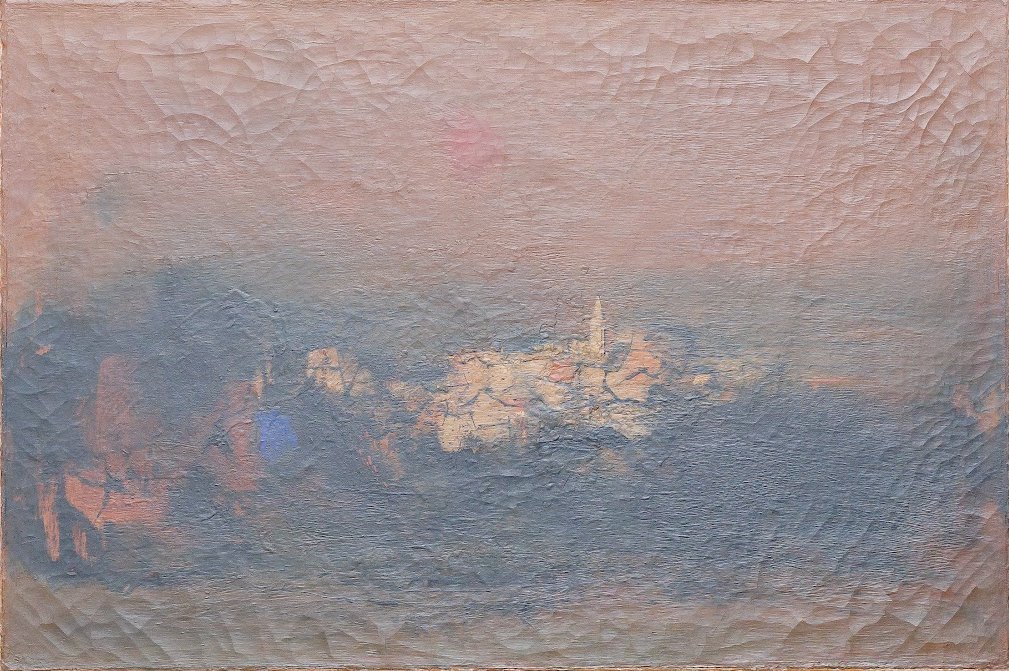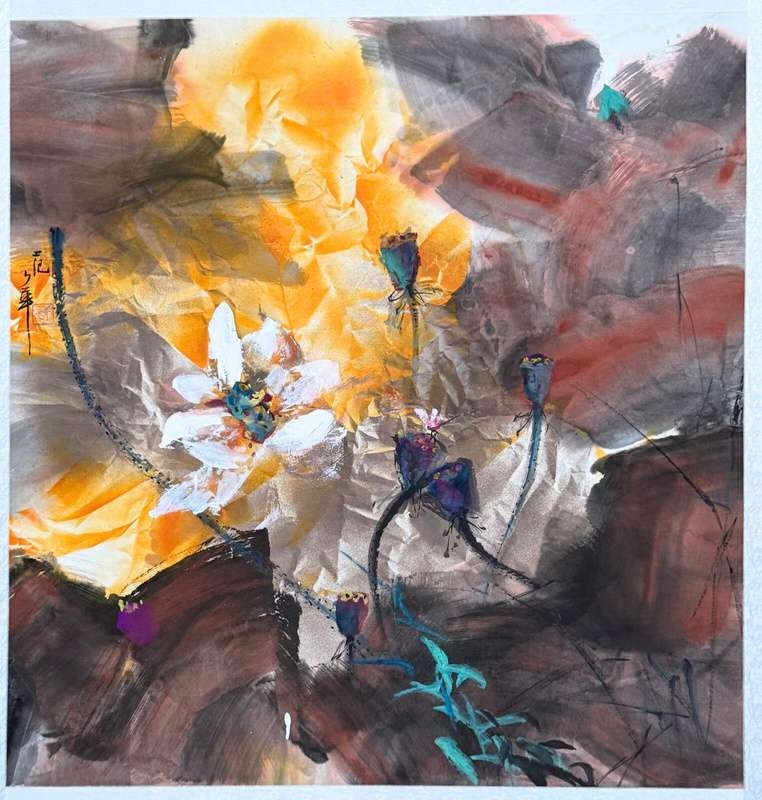Acrylic Painting on Canvas Team Bonding Art Jamming Singapore Visual Arts Centre
























Yeo Hoe Koon
Oil on Canvas
64 x 89.5 cm
Price Range: $16,000 - $20,000

Yeo Hoe Koon
Oil on Canvas
101 x 123 cm
Price Range: $26,000 - $32,000

Chen Wen Hsi
Chinese Ink and Color on Paper
50 x 54cm
Price Range: SGD $42,000 - $50,000

Cheong Soo Pieng
Red Tone
61 x 91.5cm
Price Range: SGD $108,000 - $138,000

Cheong Soo Pieng
Abstract Landscape
50 x 61cm
Price Range: SGD $95,000 -$128,000

Fan Shao Hua
Chinese Ink and Colour on Paper
100 x 100cm
Price Range: SGD $9,800 - $14,800

Fan Shao Hua
Chinese Ink and Colour on Paper
100 x 100cm
Price Range: SGD $8,800 - $13,800


林子平
Lim Tze Peng
Over the course of his six-decade career as an artist, the ex-schoolteacher and self-taught artist has created a vast body of work that includes oil, Chinese ink, and, most recently, reimagined calligraphic paintings that show the artist’s progression from realism to ferocious expressionism, all while painting an evocative and delicate tale of Singapore’s past as seen by the common man. In 2003, he received the Cultural Medallion for his contributions to the visual arts in Singapore.
Lim Tze Peng taught himself to paint as a child. Since he was passionate about his hobby, he painted still lifes in watercolours and oils. In 1949, he graduated from Chung Cheng High School and went on to teach at Sin Min School, a primary school in Pasir Ris at the time. In 1951, he became the principal of Sin Min School, where he stayed until 1981, when he retired. Lim was a committed student who spent his academic career pursuing his passion for painting.
In 2003, he received the Cultural Medallion for his contributions to the visual arts in Singapore.
In 2003, he received the Cultural Medallion for his contributions to the visual arts in Singapore.
“林子平先生,生于1921年,曾是一位专业的教育工作者,后来成为自学成功的艺术家。作为中正校友,他在八十年代初期凭借一系列以独立后新加坡地标为主题的水墨画作品受到广泛关注。自小,林子平就孜孜不倦地研习书法,在中正求学期间曾受到杰出书法家黄载灵老师的启蒙。深厚的书法底蕴为他日后的创作打下了良好的基础,无论是他的水墨画还是西洋油画,我们都能清晰地看到书法笔墨线条的痕迹。
在从教学转向绘画后,林子平的艺术生涯在各个重要的画展中展现了无穷的创造力。尽管在1981年退休,他依然保持着对美术创作的热情。林子平在巴西立长大,学校的教学经历,包括在新民学校的工作,为他的美术事业打下了坚实的基础。
多年来,他苦心孤诣地精进自己的创作。到2000年底,他开创了“糊涂字”和彩色书法,为传统书画注入了创新的元素。这些作品根植于中华书法的传统,却从中展现出强烈的现代感。
从描绘牛车水昔日风景画到抽象表达,林子平的艺术风格不断演变。他是新加坡第一位在北京和上海成功举办画展的艺术家。他曾于1963年、1981年和2016年三度获颁国庆勋章。2003年,他获得新加坡艺术界的最高荣誉——文化奖章,以肯定他对新加坡艺坛所作出的杰出贡献。
他的妻子无私的支持成为他在百岁生活中的支柱。”
Commonwealth Art Exhibition
Lim received the Special Prize at the 1977 Commonwealth Art Exhibition in England, highlighting his international acclaim.
Cultural Medallion Recipient
Lim was awarded Singapore’s highest artistic honor, the Cultural Medallion, recognizing his significant contributions to the nation’s cultural landscape.
Pioneer Exhibition in China
He became the first Singaporean artist invited to exhibit at the National Art Museum of China in Beijing, followed by a showcase at the Liu Haisu Art Museum in Shanghai.
Artistic Evolution
His transition from traditional landscapes to expressive calligraphy in his later years has been widely celebrated, showcasing his adaptability and continuous growth as an artist.
The Spirit of Ink
Showcased at the Dr. Bhau Daji Lad Museum in Mumbai, India, highlighting his mastery in ink painting.
A Century of Memories
Presented by Ode To Art, this virtual exhibition featured 20 new works reflecting on Singapore’s transformation.
Soul of Ink: Lim Tze Peng at 100
Held at The Arts House, this exhibition celebrated his centennial year with a showcase of his masterpieces.
From Lion City to London
Exhibited at the Saatchi Gallery in London during the Start Art Fair, marking his presence on the international stage.
Becoming Lim Tze Peng
A major solo exhibition at the National Gallery Singapore, tracing his artistic journey and evolution.
126 x 148cm
SGD $93,600 – $138,000
Born in Singapore in 1921, Lim Tze Peng (林子平) is one of Singapore’s most significant artists and the longest living and working artist who had passed on in 2025, at 103 years old. Lim is renowned for his Chinese ink creations of post-independence Singapore, and his signature modern Chinese calligraphy – 糊 涂字.
Lim has been bestowed several awards including the Special Prize at the Commonwealth Art Exhibition in England in 1977 and the prestigious Cultural Medallion in Singapore in 2003. In May 2012, he had broke the auction record for the highest price for a work by a Singaporean living artist with the artwork “Singapore River Scene” (1978) having sold at US$160,392 on hammer at a Christies auction sale in Hong Kong,
Alongside local and international exhibitions, his masterpieces are exhibited in prominent Singapore institutions and is part of many prestigious collections.
67 x 132cm
SGD $96,000 – $198,000
Born in Singapore in 1921, Lim Tze Peng (林子平) is one of Singapore’s most significant artists and the longest living and working artist who had passed on in 2025, at 103 years old. Lim is renowned for his Chinese ink creations of post-independence Singapore, and his signature modern Chinese calligraphy – 糊 涂字.
Lim has been bestowed several awards including the Special Prize at the Commonwealth Art Exhibition in England in 1977 and the prestigious Cultural Medallion in Singapore in 2003. In May 2012, he had broke the auction record for the highest price for a work by a Singaporean living artist with the artwork “Singapore River Scene” (1978) having sold at US$160,392 on hammer at a Christies auction sale in Hong Kong,
Alongside local and international exhibitions, his masterpieces are exhibited in prominent Singapore institutions and is part of many prestigious collections.
100 x 103cm
SGD $34,800 – $52,000
Born in Singapore in 1921, Lim Tze Peng (林子平) is one of Singapore’s most significant artists and the longest living and working artist who had passed on in 2025, at 103 years old. Lim is renowned for his Chinese ink creations of post-independence Singapore, and his signature modern Chinese calligraphy – 糊 涂字.
Lim has been bestowed several awards including the Special Prize at the Commonwealth Art Exhibition in England in 1977 and the prestigious Cultural Medallion in Singapore in 2003. In May 2012, he had broke the auction record for the highest price for a work by a Singaporean living artist with the artwork “Singapore River Scene” (1978) having sold at US$160,392 on hammer at a Christies auction sale in Hong Kong,
Alongside local and international exhibitions, his masterpieces are exhibited in prominent Singapore institutions and is part of many prestigious collections.
100 x 103cm
SGD $34,800 – $52,000
Born in Singapore in 1921, Lim Tze Peng (林子平) is one of Singapore’s most significant artists and the longest living and working artist who had passed on in 2025, at 103 years old. Lim is renowned for his Chinese ink creations of post-independence Singapore, and his signature modern Chinese calligraphy – 糊 涂字.
Lim has been bestowed several awards including the Special Prize at the Commonwealth Art Exhibition in England in 1977 and the prestigious Cultural Medallion in Singapore in 2003. In May 2012, he had broke the auction record for the highest price for a work by a Singaporean living artist with the artwork “Singapore River Scene” (1978) having sold at US$160,392 on hammer at a Christies auction sale in Hong Kong,
Alongside local and international exhibitions, his masterpieces are exhibited in prominent Singapore institutions and is part of many prestigious collections.
145 x 365cm
SGD $102,000 – $122,000
Born in Singapore in 1921, Lim Tze Peng (林子平) is one of Singapore’s most significant artists and the longest living and working artist who had passed on in 2025, at 103 years old. Lim is renowned for his Chinese ink creations of post-independence Singapore, and his signature modern Chinese calligraphy – 糊 涂字.
Lim has been bestowed several awards including the Special Prize at the Commonwealth Art Exhibition in England in 1977 and the prestigious Cultural Medallion in Singapore in 2003. In May 2012, he had broke the auction record for the highest price for a work by a Singaporean living artist with the artwork “Singapore River Scene” (1978) having sold at US$160,392 on hammer at a Christies auction sale in Hong Kong,
Alongside local and international exhibitions, his masterpieces are exhibited in prominent Singapore institutions and is part of many prestigious collections.
88 x 95cm
SGD $15,600 – $19,300
Born in Singapore in 1921, Lim Tze Peng (林子平) is one of Singapore’s most significant artists and the longest living and working artist who had passed on in 2025, at 103 years old. Lim is renowned for his Chinese ink creations of post-independence Singapore, and his signature modern Chinese calligraphy – 糊 涂字.
Lim has been bestowed several awards including the Special Prize at the Commonwealth Art Exhibition in England in 1977 and the prestigious Cultural Medallion in Singapore in 2003. In May 2012, he had broke the auction record for the highest price for a work by a Singaporean living artist with the artwork “Singapore River Scene” (1978) having sold at US$160,392 on hammer at a Christies auction sale in Hong Kong,
Alongside local and international exhibitions, his masterpieces are exhibited in prominent Singapore institutions and is part of many prestigious collections.
68 x 68cm
SGD $39,000 – $68,000
Born in Singapore in 1921, Lim Tze Peng (林子平) is one of Singapore’s most significant artists and the longest living and working artist who had passed on in 2025, at 103 years old. Lim is renowned for his Chinese ink creations of post-independence Singapore, and his signature modern Chinese calligraphy – 糊 涂字.
Lim has been bestowed several awards including the Special Prize at the Commonwealth Art Exhibition in England in 1977 and the prestigious Cultural Medallion in Singapore in 2003. In May 2012, he had broke the auction record for the highest price for a work by a Singaporean living artist with the artwork “Singapore River Scene” (1978) having sold at US$160,392 on hammer at a Christies auction sale in Hong Kong,
Alongside local and international exhibitions, his masterpieces are exhibited in prominent Singapore institutions and is part of many prestigious collections.
67 x 67cm
SGD $39,000 – $68,000
Born in Singapore in 1921, Lim Tze Peng (林子平) is one of Singapore’s most significant artists and the longest living and working artist who had passed on in 2025, at 103 years old. Lim is renowned for his Chinese ink creations of post-independence Singapore, and his signature modern Chinese calligraphy – 糊 涂字.
Lim has been bestowed several awards including the Special Prize at the Commonwealth Art Exhibition in England in 1977 and the prestigious Cultural Medallion in Singapore in 2003. In May 2012, he had broke the auction record for the highest price for a work by a Singaporean living artist with the artwork “Singapore River Scene” (1978) having sold at US$160,392 on hammer at a Christies auction sale in Hong Kong,
Alongside local and international exhibitions, his masterpieces are exhibited in prominent Singapore institutions and is part of many prestigious collections.
120 x 120cm
SGD $58,000 – $69,000
Born in Singapore in 1921, Lim Tze Peng (林子平) is one of Singapore’s most significant artists and the longest living and working artist who had passed on in 2025, at 103 years old. Lim is renowned for his Chinese ink creations of post-independence Singapore, and his signature modern Chinese calligraphy – 糊 涂字.
Lim has been bestowed several awards including the Special Prize at the Commonwealth Art Exhibition in England in 1977 and the prestigious Cultural Medallion in Singapore in 2003. In May 2012, he had broke the auction record for the highest price for a work by a Singaporean living artist with the artwork “Singapore River Scene” (1978) having sold at US$160,392 on hammer at a Christies auction sale in Hong Kong,
Alongside local and international exhibitions, his masterpieces are exhibited in prominent Singapore institutions and is part of many prestigious collections.
159 X 267cm
SGD $108,000 – $132,000
Born in Singapore in 1921, Lim Tze Peng (林子平) is one of Singapore’s most significant artists and the longest living and working artist who had passed on in 2025, at 103 years old. Lim is renowned for his Chinese ink creations of post-independence Singapore, and his signature modern Chinese calligraphy – 糊 涂字.
Lim has been bestowed several awards including the Special Prize at the Commonwealth Art Exhibition in England in 1977 and the prestigious Cultural Medallion in Singapore in 2003. In May 2012, he had broke the auction record for the highest price for a work by a Singaporean living artist with the artwork “Singapore River Scene” (1978) having sold at US$160,392 on hammer at a Christies auction sale in Hong Kong,
Alongside local and international exhibitions, his masterpieces are exhibited in prominent Singapore institutions and is part of many prestigious collections.
67 x 66cm
SGD $48,000 – $68,000
Born in Singapore in 1921, Lim Tze Peng (林子平) is one of Singapore’s most significant artists and the longest living and working artist who had passed on in 2025, at 103 years old. Lim is renowned for his Chinese ink creations of post-independence Singapore, and his signature modern Chinese calligraphy – 糊 涂字.
Lim has been bestowed several awards including the Special Prize at the Commonwealth Art Exhibition in England in 1977 and the prestigious Cultural Medallion in Singapore in 2003. In May 2012, he had broke the auction record for the highest price for a work by a Singaporean living artist with the artwork “Singapore River Scene” (1978) having sold at US$160,392 on hammer at a Christies auction sale in Hong Kong,
Alongside local and international exhibitions, his masterpieces are exhibited in prominent Singapore institutions and is part of many prestigious collections.
250.5×211.5cm
SGD $102,000 to $122,000
Born in Singapore in 1921, Lim Tze Peng (林子平) is one of Singapore’s most significant artists and the longest living and working artist who had passed on in 2025, at 103 years old. Lim is renowned for his Chinese ink creations of post-independence Singapore, and his signature modern Chinese calligraphy – 糊 涂字.
Lim has been bestowed several awards including the Special Prize at the Commonwealth Art Exhibition in England in 1977 and the prestigious Cultural Medallion in Singapore in 2003. In May 2012, he had broke the auction record for the highest price for a work by a Singaporean living artist with the artwork “Singapore River Scene” (1978) having sold at US$160,392 on hammer at a Christies auction sale in Hong Kong,
Alongside local and international exhibitions, his masterpieces are exhibited in prominent Singapore institutions and is part of many prestigious collections.
Click and get to our WhatsApp
Embark on a captivating journey into the vibrant world of digital art! Our Foundation in Digital Art workshop invites budding creatives aged nine and above to unleash their imagination and hone their artistic skills in a dynamic, supportive environment. From mastering basic digital tools to crafting mesmerizing digital masterpieces, children will explore a spectrum of techniques guided by seasoned mentors. Through hands-on activities and interactive sessions, participants will discover the endless possibilities of digital expression while fostering creativity and critical thinking. Join us for an exhilarating adventure where young artists transform ideas into stunning visual realities, igniting a passion for digital art
In the Batik Introduction Handkerchief Painting workshop, participants will learn the traditional art of batik, a wax-resist dyeing technique originating from Indonesia. The workshop begins with a brief history and overview of batik, highlighting its cultural significance and various techniques. Participants will then observe a demonstration of applying wax with tjanting tools and dyeing the fabric. Following the demonstration, each participant will design and create their own batik handkerchief, applying wax to create patterns and then dyeing their fabric. The workshop concludes with a group discussion, allowing participants to share their creations and reflect on their learning experience.